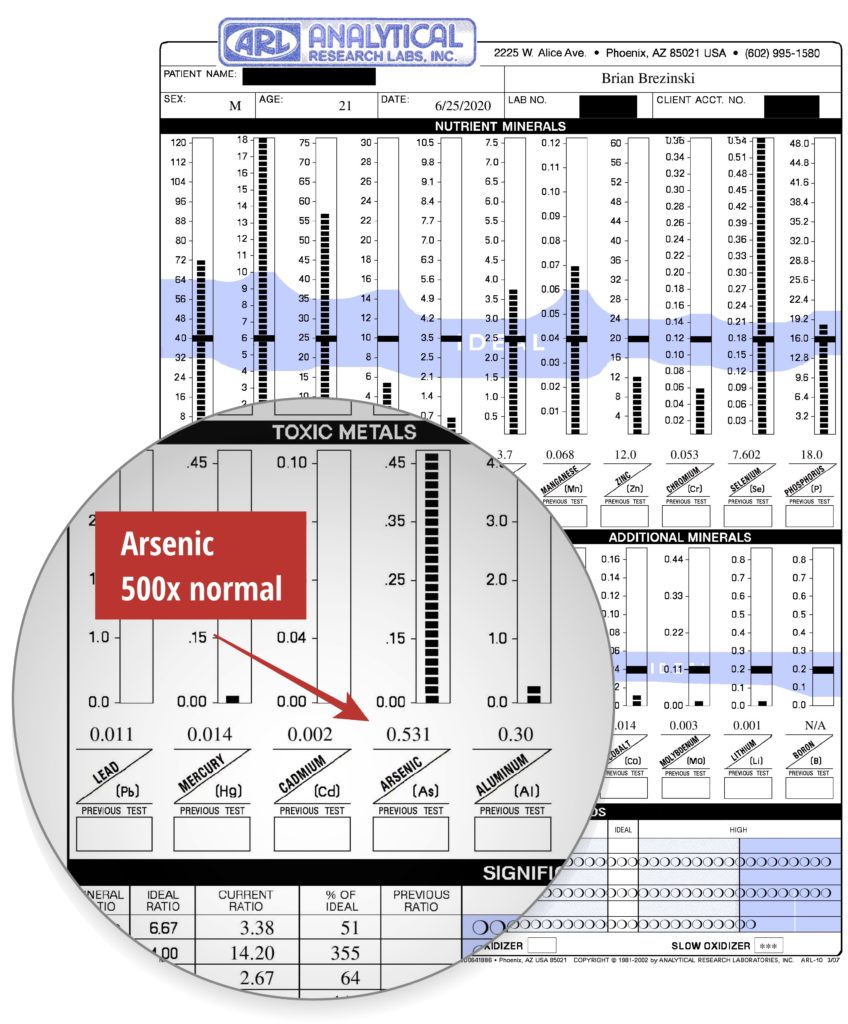Rice and Arsenic Toxicity: A Case Study
- Published on
- by Brian Brezinski
All information in this article is for educational purposes only. It is not for the diagnosis, treatment, prescription or cure of any disease or health condition.
I recently reviewed the hair analysis results of a 21-year-old college student, who I’ll call Joe.
Joe’s main health concerns were stomach pain, allergies, brain fog, and headaches. He also reported having sinus congestion, fatigue, eczema, confusion, irritability, depression, OCD, diarrhea, and bloating.
Joe reached out to do a hair analysis because he was having trouble concentrating in school, which he said was becoming very stressful.
Joe’s First Hair Analysis
Joe’s hair analysis revealed several important imbalances. One of the most notable was an arsenic level of .531 mg%, which is 500x the normal level!

What is Arsenic?
Arsenic is a highly toxic metal that is prevalent on planet earth. It occurs naturally in conjunction with gold, copper, zinc, lead, and other metals. Therefore, it is a common by-product of mining and smelting.
Arsenic is famous for being used as a food poison to silently kill a person. It has been used throughout history to kill off kings and emperors, earning the name the “poison of kings”.
Dr. Lawrence Wilson, a holistic physician who studies toxic metals, calls arsenic the slow death mineral because it causes vague symptoms that are hard to trace. He also calls it the slave mineral and the dullness mineral because it takes away a person’s will to resist, and it causes mental dullness and apathy.
Arsenic has a shorter biological half-life (less than 20 hours) than many of the toxic metals. This means that it is easier for the body to remove. However, high doses or regular exposure will cause arsenic to accumulate in the body.
Symptoms and Health Effects of Arsenic Toxicity
At first, arsenic exposure causes low-key symptoms such as fatigue, weakness, and malaise. Continued exposure leads to more distinct symptoms, including:
- Abdominal pain
- Headaches
- Diarrhea
- Confusion
- Skin lesions and pigment changes
- Hair loss
- Muscle cramping and spasms
Long term arsenic exposure can lead to more significant health issues, such as diabetes, heart disease, and neurological problems. Arsenic is also linked to several forms of cancer (bladder, lung, skin).
Arsenic is particularly dangerous for pregnant women and developing infants. Many adverse outcomes have been linked to arsenic exposure during pregnancy, including increased infant mortality.
Joe’s symptoms matched almost perfectly with the main symptoms of arsenic toxicity.
Where did the Arsenic in Joe’s body come from?
Due to soil contamination around the world, many foods contain some arsenic. Arsenic is also the most significant chemical contaminant in drinking water globally, according to the World Health Organization.
Recently, however, alarming levels of arsenic were found in 200+ samples of rice products from all over the world.
With a little investigation, we determined that Joe’s arsenic exposure was coming from rice. He told me that he had been “living” on rice during his last semester at college.
Why Is Rice Contaminated with Arsenic?
Most likely, rice is contaminated with arsenic today because it is being grown in fields that were once sprayed with arsenic. Arsenic compounds were commonly used as a pesticide on tobacco, cotton, fruit trees, grapes (wine), and other crops until it was banned in the 1980s.
Arsenic-containing drugs are also fed to chickens to promote growth, kill parasites, and for other reasons. Their manure is then used as a fertilizer, adding significant amounts of arsenic to the soil.
Since 1910, about 1.6 million tons of arsenic has been used for agricultural and industrial purposes, according to Consumer Reports. These practices have thoroughly contaminated the food and water supplies everywhere on earth. Arsenic lingers in the soil indefinitely, so exposure will continue to be a problem, even though it used less frequently in agriculture today. Even organically-grown food will contain high levels of arsenic if it was grown in soil that was once treated with arsenic-based pesticides.
Rice accumulates arsenic. It appears that rice absorbs arsenic from the soil to a much greater degree than other plants. According to Current Environmental Health Reports, rice accumulates arsenic ten time more than other cereal grains such as wheat.
I admit that I downplayed the problem of arsenic in rice until I saw Joe’s hair test and the degree of toxicity that eating rice can cause.
As an aside, blood tests will not usually reveal arsenic toxicity unless the test is performed soon after exposure. This is because arsenic and other toxic metals are rapidly cleared from the blood.
Joe’s Nutritional Balancing Program
I advised Joe to stop eating rice and replace it with a nutritious whole grain such as blue corn. I also suggested a handful of nutritional supplements based on his hair analysis patterns and a specific whole-food diet to replenish essential minerals.
Joe’s program was not specifically designed to remove arsenic. Instead, his program was designed to balance his body chemistry, improve cellular energy production, and enhance detoxification. With a holistic approach, the body will remove all of the toxic metals in due time. This is a much safer approach than using chelating drugs to remove arsenic and other toxic metals.
I will report here if Joe follows through with our recommendations, along with any of his future hair tests. Join my email list below to receive updates about new articles.
To learn more about hair analysis, click here: Hair Analysis Test (HTMA)
Share This Post
More Articles
-
Three Things Smart Women Avoid at All Costs: Part 1
-
Copper Toxicity from Permanent Retainer (Dental Materials): A Case Report
-
ARL vs TEI: Which is the Best Hair Analysis (HTMA) Lab Test?
-
How much does hair mineral analysis (HTMA) cost?
-
Copper IUD Warning!
-
3 Lesser-Known Stimulants that May Be Harming Your Health
-
The Dangers of Cold Plunging
-
How and When to Eat Liver
-
Basic Supplements
-
Understanding Your HTMA Test Results (Video Series)

